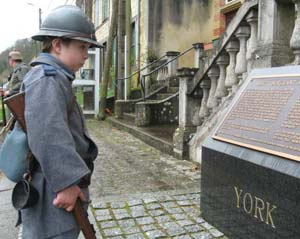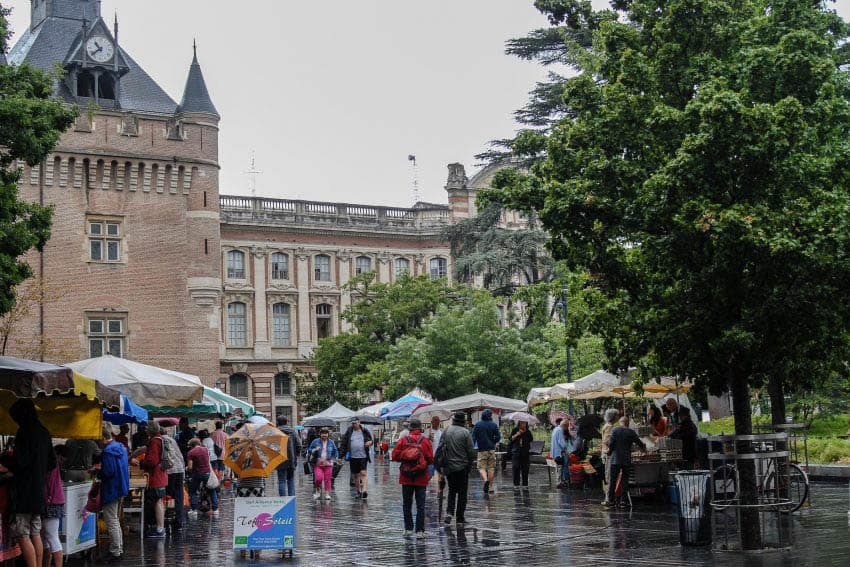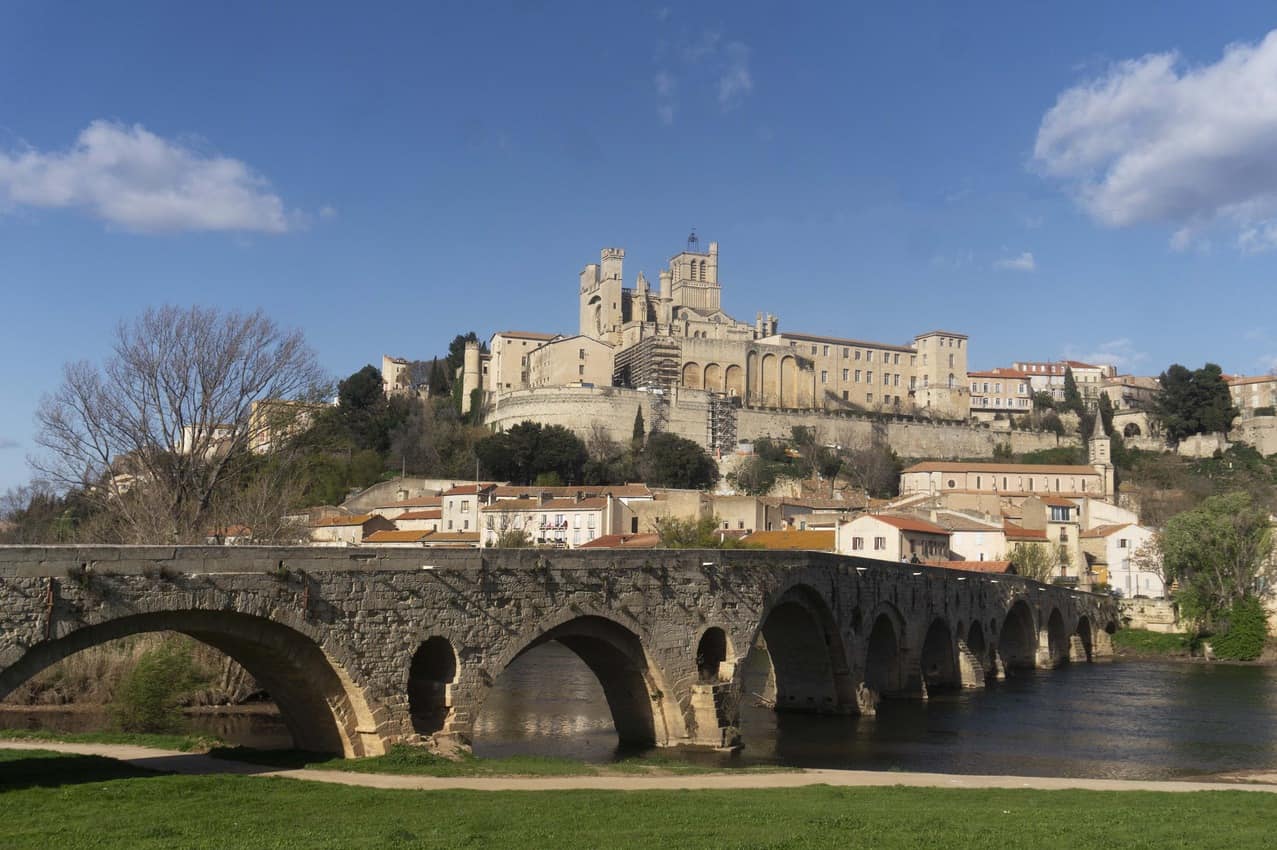World War 1 American Offensive Remembered
“That our children may be patriots, we tell them of our fathers.”
By Richard Frisbie
During a recent visit to France, which was planned more for viticulture than history, it became impossible to ignore all the military monuments and cemeteries set in the green fields and vineyards of the beautiful farmland north of Paris.
Vague references to the Western Front, the Maginot Line, and the Battle of Verdun, remembered from my history lessons of so long ago, became clearer as the historic markers and museum displays explained the course of two world wars and the role Americans played in them.
Finally the realization that “It all happened here!” woke me to the importance we (meaning Americans) had in this region, especially for the Great War, World War I.
Everywhere I went was historically connected to America’s part in the war, and everyone I met had a story to connect them to the horrors that occurred during those long years of battle. Conversations about grape harvests, architecture, gastronomy, and even trees all led back to “The War”.
What a majority of Americans know about World War I, if they know anything, does not have the immediacy of the knowledge of someone whose local church walls still have evidence of bullets and shrapnel damage, or whose village had to be completely rebuilt after being leveled by the Germans.
The beautiful French countryside is still pockmarked with the holes of mortar shells and crisscrossed with the trenches of both armies. This section of France was a battlefield!
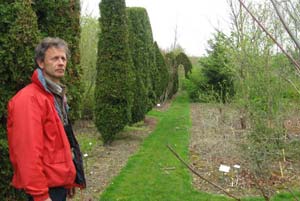
It isn’t that Americans don’t care about the war, it was that it happened, to quote from popular songs of the period, “over there” and not on our own “home front”. Much of my visit was spent explaining that distinction to the people I met, and hearing from the hearts of French men and women how much it meant to them that the Americans came and fought beside them to liberate the French countryside.
Of the 2,084,000 Americans in France in WW I (42 Divisions), 122,500 died – 48,909 in battle. More men died of disease than any other cause. It was a war America fought on foreign soil where, in victory, we asked only for enough land to bury our dead. This year, the 90th anniversary of the end of World War I, is filled with events commemorating these valiant and heroic Americans.
I Met A Man Who Loved His Willows
The Champagne region of France is known for its baskets woven from willow branches. In fact, the French National School of Basket Weaving is located in Champagne.
So the next time you think of Champagne, think of baskets, not bubbly, and you’ll win the admiration of Dominique Brochet-Lanvin.

Dominique Brochet-Lanvin, along with his wife, son, dog and a few rascally puppies, calls Botanique de la Presle home. It is their arboretum, nursery and labor of love in the French countryside outside of Epernay in Montagne de reims.
Dominique is a salixophile, or lover of willows. “There are 500 to 600 varieties of salix” he told me. “No one knows for sure. I’m trying to collect them all here.”
When I told him that I only knew of the weeping willow, he said, “As we say in France, that is the one that hides the rest.” Then he told me a charming story that is so typical of the French.
“Before he died, Napoleon requested that a weeping willow be planted on his grave. It became the custom for everyone who visited his tomb to take a cutting home to plant. His weeping willow spread around the world. Now, what he couldn’t conquer in life he has dominion over through his millions of willows.”
After the bread, the wine and now the willows, it is for stories like this that I love the French people.
Willows have many other uses. During World War I the French lined their trenches with woven willow panels to hold back the earthen ramparts.

Near St. Mihiel I actually got into some of the trenches. The German trenches were original, with walls and bunkers made from huge blocks of stone.
The French trenches were reconstructed with fresh willow walls, illustrating the impermanence of their battlements.
What they built for temporary protection from the barrage of enemy shells often became semi-permanent as the trench warfare dragged on for years. And all those years their willows kept them company.
Back in the arboretum Dominique walked me through his willow collection as a light rain fell. It was perfect gardener’s weather for admiring the various black, yellow, green, and contorted stems, each with their different size and shape catkins, or flowers.
Tall, short, multi- and single-trunk bushes and trees, all willows, competed for my attention. When I recognized the pussy willow, I realized that where I used to know only two types of willows, now I knew two hundred! And still the collection went on.
We toured over 1000 feet of perennial beds bordered with short woven willow fences before finishing our walk in the old fashioned rose garden.
Here Dominique showed me a prized specimen of the La Marne rose he and his wife rescued from extinction.
Originally named in 1915 for the Battle of La Marne, this blood-red beauty was nearly lost until they discovered a “forgotten” specimen in a relative’s garden and propagated it.
Today, the Botanique de la Presle proudly sells descendants of this noble antique.
While the last French veteran of the Great War has been laid to rest, the La Marne rose lives on, a testament to the hardy French stock and the toils of two gardeners of Champagne.
I Met A Man Who Loved His Bread
M. Boizard is a lifelong baker who collected bread-related items as he baked his way into semi-retirement. Now, a new owner takes over his business while M. Boizard tends his collection, formally known as Musee du pain, but I think of it as the Bread Museum.
We met on a bridge near his home in Fismes, France. I’d stopped to photograph the crabapple trees in bloom next to a picturesque little mill along the La Vesle river.
Botanique de la Presle
03 26 59 43 39
Remembering the American Offensive in World War I
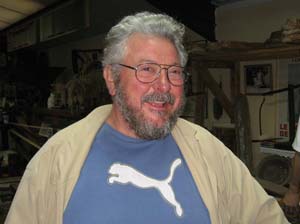
When he learned I was an American he pointed out that our 28th Division took the bridge in 1918 after a week-long fire-fight. “Hundreds of Americans were killed to liberate my village.” he said. Then he invited me to his home.
I found this happening all over France. 2008 is the 90th anniversary of the end of World War I. France has been commemorating the anniversaries of various battles for the last four years, but through this Summer and Fall many more take place until the culmination of ceremonies on November 11th.
Everywhere I went the French people treated me as if I’d been in the Verdun trenches with them. Forget what you might have heard about the French.
They remember the World Wars better than we do. After all, the fighting happened in their door yards! They haven’t forgotten America’s help winning them, either. I was received warmly wherever I went. And so, I accepted Mr Boizard’s invitation.
With his little English and my nonexistent French, it is no wonder I misunderstood. It wasn’t to his home we went, but down an alley next to the bridge, where I soon found myself in his bread museum.
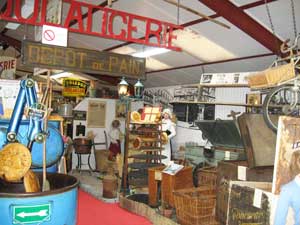
Outside he had a large German wood-burning oven on wheels which is still towed to events and used. There were also two antique tractors, one French c1957 and the other a 1955 English one. Both were once used to harvest wheat, and both still run!
The inside is more difficult to describe. There was so much stuff packed into one large room that my eyes at first couldn’t focus on just one thing. Gradually, though, I discerned a path to follow, beginning with early bread-making implements and eventually leading up to the present time.
Here was everything to do with bread under one roof! There were tools and machines for mixing, shaping, baking, twisting, rising, even for harvesting and reaping the wheat.
Everything from animated displays to antique examples of bread-making art. I even watched a video in English showing how French bread was made. With floor-to-ceiling displays it was obvious that bread was truly his passion.
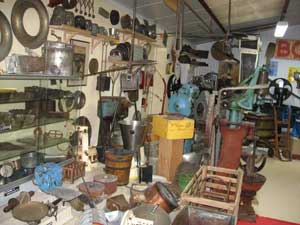
There were some models and images of local windmills where the grain was ground. He told me that in World War I the Germans machine-gunned the blades off the windmills because the French Resistance used them to point out where enemy bunkers were hidden and munitions stored.
That meant the French were often without flour for bread until the American liberation. That explained why he also had three flour sacks on display labeled US FLOUR.
The soldiers who saved the village brought the ingredients for the French staff of life – bread – and there’s nothing more important to a Frenchman. No wonder they were treated like heroes!
Over flutes of champagne, he showed off his proudest memento. It was the newspaper account of his induction into La Commanderie de France des Talmeliers Bon Pain, the organization of French bread lovers.
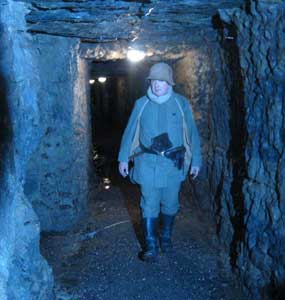
His homage to bread, his museum, earned him an honorary membership in this prestigious fraternity of bakers. It also earns him mention here as a man who followed his passion to create an incredible monument to bread.
Musee du Pain
03 26 48 00 13
Admission 3.5 Euros
I Met A Man Who Loved America
It was cold and raining when I pulled into the muddy parking area of the Moreau Valley Camp. Men in rain gear and antique uniforms milled around the other vehicles getting ready to recreate the life of the soldiers in WW I.
They were part of a re-enactors group that had refurbished the original power station, showers, and underground passages of a fortified German position in Marne on the Western Front. I was joining them to experience life in the trenches.
My French guide through the labyrinth of tunnels had the unlikely name of Serge Tourovsky. He explained his last name by saying that he indeed was French, but with a Russian father.
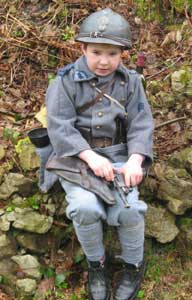
During the course of the morning he changed from German, into French and finally American uniforms as we ducked through dripping passages, exploring the securely constructed compound.
Several times we emerged onto a hillside with a small stream coursing along the base. Down the slope were terraces off which corrugated metal-roofed rooms were dug into the earth. Most held two sets of bunk beds, but one was a delousing room and one was made of concrete, divided into shower rooms for officers and enlisted men.
At the base was a latrine, a laundry area, and mess room. This was an efficiently designed and highly fortified little village. Viewing it, I began to understand why it was so difficult for the Allied forces to remove the entrenched German army.
Serge was joined by his son, 10-year-old Geoffrey, also in uniform. He nonchalantly field-stripped his weapon, a lethal-looking toy replica pistol, and looked in every respect like a little soldier.
It was unnerving to see father and son together, an armed and uniformed Mutt and Jeff team, pulling me visually into the WW I era with every turn in the trenches. It gave me the shivers! I blamed it on the cold rain and ducked into the mess bunker for hot coffee. Over steaming cups of strong French brew Serge told me about the Camp.
“We reenact French life in the trenches for the tourists. On Saturdays from July through September we have the sound of artillery along with the flashing lights of explosions to really give them the effect of battle. After that it will be the 2nd and fourth Sundays.”
He said, “We cleaned and reconstructed the camp for free. We perform for the pleasure of sharing our history.”
The coffee was warming, but my shivers persisted. The zeal I saw in his eyes reminded me of the quote in an old history book, “That our children may be patriots we tell them of our fathers.”
Everywhere I traveled along the World War I battle front I found men like Serge. Men whose families were affected by the war; men who couldn’t let the struggle for freedom to be forgotten. He stressed that France would not be free without the help of the Americans.
As I was getting ready to leave he added this sentiment, “You are all in our hearts. May your soldiers be safe and home soon. When the time comes for the French to shed blood for our allies – we are ready. God Bless America!”
The Eleventh Hour Finale
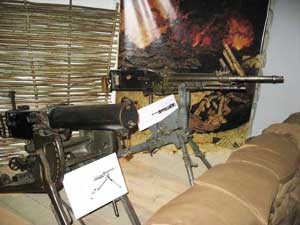
It was with tears in my eyes that I continued on my journey of exploration. Today the landscape is verdant and alive with wheat and grapevines. Ninety years ago it was a desolate moonscape of charred trees, the air choking with the rotting stench of death.
Serge’s words echoed in my mind as the monuments to the battles and the cemeteries of the dead blurred in their multitude. Millions of lives were lost in this War To End All Wars.
As the 90th Anniversary Commemorations build to the Eleventh Hour finale, I think of our comrades-in-arms, and the deep ties of the American and French people whose soldiers fought side-by-side from 1776 onward to preserve the freedoms we all enjoy today. “God Bless America!” indeed, and “Viva La France!”
Background on the American Offensive in Northern France in WW I
Although the United States did not officially enter the war until April 6th, 1917, there were in fact Americans in the Meuse much earlier. Volunteer American ambulance corps helped transport the wounded in 1915. A year later America’s famous Lafayette Squadron could be seen in the skies above Verdun.
But it wasn’t until June 1st, 1917, when 20,000 men of the 1st Infantry Division landed in St. Nazaire that America was officially in the war. By the end of the following month they were in position at Gondrecourt-le-Chateau in the southeast of the Meuse.

At the time the whole American army consisted of only 200,000 poorly equipped soldiers, so the French had to provide cannons, machine guns, rifles and munitions as well as the necessary training.
After the US Conscription Law was passed these numbers increased to 77,000 by the beginning of November, and within five months, to 335,000.
The Meuse was actually the first battle for the US Army on foreign soil. The arrival of American troops provided necessary relief for the war-weary French soldiers and precipitated the end of the War.
Besides helping to liberate France, the Americans also contributed greatly to the reconstruction effort in the Meuse. Many town halls, hospitals, schools and water towers were rebuilt with the financial aid of American individuals and institutions. They stand today as a testament to the generosity of the American people and the close ties both countries enjoy.
There are more than 80 memorials commemorating the WW I American presence in Meuse. The American Cemetery of Saint Mihiel (Thiaucourt, Meurthe-et-Moselle) has 4,153 graves. At Romagne-sous-Montfaucon in the Argonne, the 130 acre cemetery is the largest burial site from both World Wars in Europe with 14,246 graves.
Impressive Memorials have been built by the Americans at Montsec and Montfaucon d’Argonne. The States of Pennsylvania and Missouri, plus many institutions and individual regiments built monuments at Argonne, Nantillois and other places.
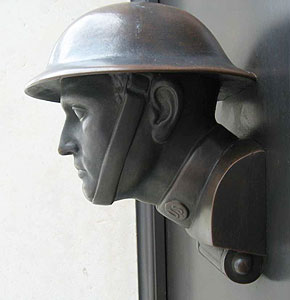
Several statues, steles and obelisks pay tribute to the vital role played by the US forces in the Meuse 90 years ago.
Information and Links
Meuse Tourism Office
There are over 80 monuments dedicated to the USA in the Meuse. Hightlights include the Argonne Battlefield, Saint-Mihiel Salient, Thiaucourt Cemetery, Verdun and the Red Zone, Fort Douaumont, Douaumont Ossuary, Verdun Memorial Museum, Citadel and, from late June through July see the recreation of the Battle of Verdun as the largest sound & light show in France on Friday & Saturday nights.
Reims Tourism Office
John D. Rockefeller, Jr. donated money to rebuild the Notre-Dame de Reims cathedral, the Andrew Carnegie Foundation donated money to build the municipal library, and Americans donated money for the Children’s Hospital of Reims. Also, as a WW II site, the museum of the surrender of the Third Reich’s German Armies is in the map room of the Franklin D. Roosevelt High School, (which was the Supreme Headquarters Allied Expeditionary Forces.) The surrender ended the Second World War in Europe.
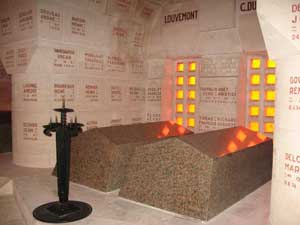
La Marne Tourism Office
Moreau Valley Camp, Navarin Monument remembering 10,000 unknown soldiers who died in the battles for Champagne, this includes Teddy Roosevelt’s son Quenton’s remains and plaques to the Rainbow Division. Also see the American Monument at Blanc Mont commemorating the 70,000 American soldiers who fought there. The Circuit of Remembrance is a self-guided tour in the footsteps of the Armies of Champagne –
Lodging
Château des Monthairons
55320 Dieue-sur-Meuse
Tel : +33 (0)329 87 78 55 – Fax : +33 (0)329 87 73 49
Rate: 120 Euros and up
Hôtel Cosmos
88140 CONTREXEVILLE
Tél: +33 (0)329 07 61 61 – Fax: +33 (0)329 08 68 67
Rates: 110 Euros and up
Hôtel de Guise
13 rue de Guise – 54000 Nancy
Tél +33 (0)383 32 24 68
Rates: 64 Euros and up, Breakfast 8 Euros

Hôtel de la Cathédrale
25 place de Chambre – 57000 METZ
Tel : +33 (0)387 75 00 02 – Fax : +33 (0)387 75 40 75
Rates 68 Euros and up, Breakfast 11 Euros
Hostellerie du Coq Hardi
8 avenue de la Victoire – 55100 Verdun
Tel : +33 (0)329 86 36 36 – Fax : +33 (0)329 86 09 21
Rates: 99 Euros and up, Breakfast 16 Euros
Hôtel du Cheval Rouge
1, rue Chanzy – 51800 SAINTE-MENEHOULD
Tél. : +33 (0)326 60 81 04 – Fax : +33 (0)326 60 93 11
Rate: 48 Euros and up, Breakfast 5.8 Euros
Hôtel Restaurant Le Tulipier
Rue Saint-Jacques – 51800 Vienne-le-Château
Tél : +33 (0)326 60 69 90 – Fax : +33 (0)326 60 69 91
Rate: 80 Euros Breakfast 8.5 Euros
Best Western Hôtel de la Paix
9, rue Buirette – 51100 Reims
Tel. +33 326 400 408
Rate: 140 Euro and up, Breakfast 13 Euros
Furthermore
Information of vineyards, wine and champagne tastings, churches, restaurants, shopping and the many other places of interest are all available at the above tourism websites.
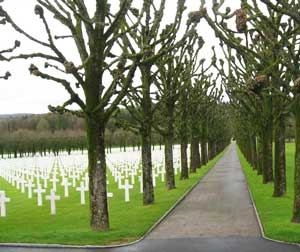
Commemorative Events
The commemorations highlight the part played by the Americans in ending World War I.
Their involvement was fundamental and is an integral part of the commemorative heritage.
“LIBERATION DU SAILLANT DE SAINT-MIHIEL” (Liberation of the Saint-Mihiel Salient) reenactment on September 13 in the Montsec district.
A SOUND-AND-LIGHT SHOW MARKING THE LIBERATION OF THE ARGONNE in Montfaucon d’Argonne on September 26 & 27, October 3 & 4, 2008 to be staged by the Connaissance de la Meuse Association – the organizers of France’s second largest sound and light show.
INTERNATIONAL SYMPOSIUM in February and September on the role of the Americans in 1917- 1918
CONCERTS DURING THE SUMMER on the theme of “La musique Americaine en 1918” (American music in 1918)
OPEN-AIR SCREENING in July and August: “Les Americains et la Grande Guerre” (The Americans and the Great War)(Saillant de Saint-Mihiel, Verdun, and Argonne)
EXHIBITION ABOUT THE AMERICAN OFFENSIVE IN THE MEUSE from October 2008 to the end of 2009, Verdun
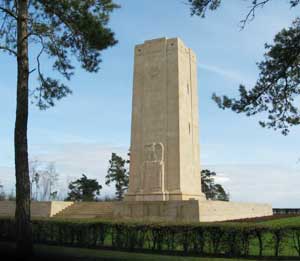
ILLUMINATION of the road from Saint-Mihiel to Montfaucon, SYMBOLISING THE JOURNEY OF AMERICAN TROOPS from the Saint-Mihiel Salient to Argonne, on September 20
SALON DU LIVRE D’HISTOIRE (exhibition of the history-book) in Verdun, from 9 -11 November 2008
COMMEMORATION ON NOVEMBER 11: The bells of the Meuse will chime and the names of the US soldiers buried at Romagne sous Montfaucon will be read out.
The above events are free. (This provisional program is subject to change)
.
Note also that in June and July 2008, THE SOUND-AND-LIGHT SHOW “DES FLAMMES A LA LUMIERE” (From Flames to Light) presented by Connaissance de la Meuse is to be enhanced by the addition of a new scene about the Americans in World War I. Translation is available through headphones.
In the Marne County, walking commemorative tours are planned all year long.
Contact tourisme-meuse.com for further information about these and other WW I commemorative events.
Check GoNOMAD listings for flights to France
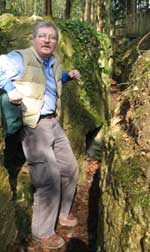 Richard Frisbie has been writing culinary travel articles for more than five years as a columnist for his local newspapers, and as a regular contributor to many Hudson Valley, Catskill Mountain and other regional New York publications. His most recent addition to that list is a wine column called “Fruit of the Vine” for Life in the Finger Lakes magazine. Online, he writes frequent articles for EDGE publications and TravelLady.com, as well as Gather.com.
Richard Frisbie has been writing culinary travel articles for more than five years as a columnist for his local newspapers, and as a regular contributor to many Hudson Valley, Catskill Mountain and other regional New York publications. His most recent addition to that list is a wine column called “Fruit of the Vine” for Life in the Finger Lakes magazine. Online, he writes frequent articles for EDGE publications and TravelLady.com, as well as Gather.com.
Read more GoNOMAD stories by Richard Frisbie:
Macau: The Birthplace of Asian Fusion Cuisine
Brazil’s Emerald Coast: The State of Rio de Janeiro
Tasting French Champagne: A Transcendent Experience
- These 9 U.S. National Parks Require Reservations in 2024 - April 17, 2024
- Take a Hike in Olympic National Park - April 17, 2024
- The Wild Mississippi: 2340 Miles Across Ten States - April 8, 2024

